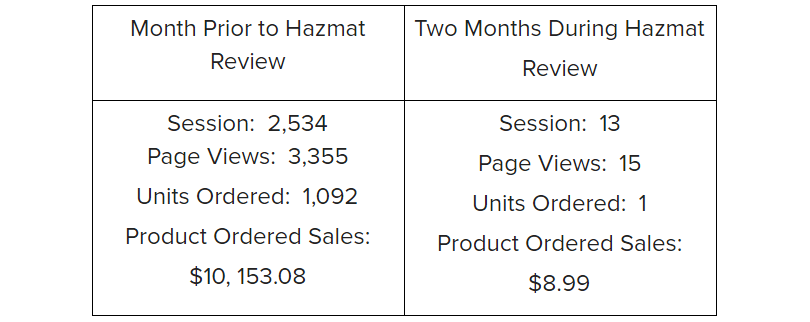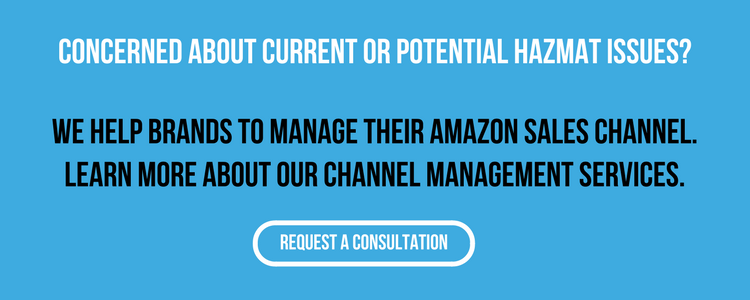There are a number of horror stories on the internet where sellers have witnessed their products being flagged Hazmat overnight; especially surprising since some of these products are entirely harmless or have been selling on Amazon for a while! It is quite a confusing topic of discussion and has left many sellers at wits end due to the unpredictable nature of the issue. What’s the whole story and how does it affect you and your brand?
Amazon and Hazmat
It is first important to understand Amazon and their Dangerous Goods/Hazmat policy as most sellers are unaware that they might be selling a hazardous product to begin with. Amazon restricts dangerous goods or hazardous materials defined as “substances or materials that may pose a risk to health, safety, property, or the environment while storing, handling or transporting because they contain flammable, pressurized, corrosive, or otherwise harmful substances.” (Source: Amazon) These include items that may be harmless when placed on shelves at home or stores but may pose a risk when exposed to radical movements, temperature and/or pressure fluctuations; all of which is possible during the transit, storage and shifting of products.
Amazon has recently strengthened its policy in light of the FAA proposed civil fines against Amazon for shipping hazardous products that violated their regulations and, in one particular case, led to the injury of several UPS workers who handled the Amazon package. As a result, it’s quite understandable that Amazon has had to resort to such actions. Amazon is also continuously updating its Hazmat specifications and aggressively checking all sellers’ listings in accordance to insurance, carrier, health, and safety policies. It currently requires any FBA product that may contain even the slightest hint of hazardous materials to undergo a review for the above reasons.

How does Amazon’s Hazmat policy affect you?
If you are selling a new product, the product is automatically put under Hazmat review when converting from FBM to FBA. Amazon asks if the product is a ‘Dangerous Good’ and depending on the response – yes, the hazardous screening process begins and will last at least 3 business days, or no, the product gets converted but Amazon reserves the right to flag the listing in the future. If you feel the process has stalled, after the required wait period of 3 business days, you can contact Seller Support to inquire about the status of the process. However, if the product in question is one that you have already been selling on Amazon and has been recently flagged as Hazmat, the process is much more uncertain and perplexing! This generally happens because Amazon randomly reviews their large database of listings and tags products according to its hazmat specifications. As a result, you may have your previously approved product flagged, restricted and unavailable for sale. No product category seems to be safe!
A Bobsled Marketing client selling products in the ‘Clothes, Shoes & Jewelry’ and the ‘Sports & Outdoors’ category had several product listings flagged as hazmat. Amazon asked for proof that these products were not, in fact, hazardous goods. Amazon even asked for a copy of the Material Safety Data Sheet (MSDS). In one of the cases, the products were leotards!


In Europe, another client selling under the ‘Automotive’ category, listed a series of flashlights and converted them from FBM to FBA while preparing to send the inventory to Amazon. During the product listing process, the brand was asked if these products are considered ‘Dangerous Goods’ (according to the policy) and since these flashlights contain batteries, the company answered ‘yes.’ Even after providing the required documentations such as MSDS, battery composition and additional details, the product listing stayed under hazmat review for over 30 days! Furthermore, based on Amazon’s new strict policy, they restricted this product stating that it was a ‘laser’ and therefore, a ‘Dangerous Good’ which is not allowed to sell on Amazon. This flashlight, which had been previously sold on Amazon, is now a restricted product. The Brand is appealing this decision.
Hazmat and the Health and Beauty category on Amazon
The Health and Beauty sector is a prominent avenue for sellers but one that is getting more difficult to get into. Although Amazon ungated the Health & Beauty category earlier this year, there has been a slight increase in the crackdown on individual products especially in this category. This may be the case since many of the products may list ingredients that are now on Amazon’s ever-changing Hazmat list.

Health and beauty products are also not so easy to store and handle. Since they include products that are applied to the skin or even ingested, they need to be maintained under all health and safety standards. Additionally, since the products may be liquids, gels or semi-solids, their composition may be affected when exposed to temperature and pressure changes. Transit and long duration storage can also affect its packing and structure. As a result, they may spoil or damage easily. Consumers are sure to return or complain against these products, especially of this category, as damaged or spoilt products may pose health hazards. All of this makes these products, and this category, Amazon’s top priority while reviewing for Hazmat specifications on a product basis.
Having said that, there are cases in which active products have been flagged even if they have a long history of being sold on Amazon or are being sold by Amazon itself!
A final cautionary tale from another project Bobsled worked on. A Brand selling in the Health & Beauty category had one of their best selling products flagged as hazmat. The product had been successfully sold on Amazon for several years, however, with the update of the Hazmat Review process in July 2017, this product was taken off the market for two months! Finally, after multiple appeals, documented Plan of Action reports, MSDS reports, and an unlimited amount of patience, the hazmat flag was lifted and the product listing became active once again. The most exasperating aspect of this case was that the product comes in 3 size variations and only 1 of these variations was flagged! Same product, different sizes and only one was flagged!

Above: Sales and traffic (session) data before and after a Hazmat Review. Traffic and sales came to a standstill.
What do you do if this happens to you?
It is best to determine on your own if your product is Hazmat especially since the list is modified regularly. These steps might also help you prepare in advance if your product has not yet been flagged:
- Check if your product comes under the regulations of carrier agencies or carrier regulation heads such as the U.S. Department of Transportation (DOT).
- Check if your product is regulated by the Food and Drug Administration (FDA).
- Keep yourself updated with Amazon’s Hazmat list.
- In case of buying the product from a manufacturer, you must get all the information and reports from the manufacturer to fill out the Material Safety Data Sheet (MSDS) which Amazon will prompt you to fill if your product has been flagged.
Information gathered on the basis of your research should help you prepare an individual case for your product (Plan of Action). You must be prepared to reason it out with Amazon and convince them that your product is safe for storage and transportation. A completed MSDS should be backed up with evidence from the manufacturer with precedents of the product’s nature and history. You can also support your product if transportation and storage is supported by transportation agencies and authority. Prepare your arsenal of facts as you are going to be the best advocate for your product!

What does it all come down to?
The predominant complaints from brands against Amazon’s Hazmat process is inconsistency in how the procedures are applied and the varying timeframes for review and feedback. As a result, it’s rather difficult to guess how your product will fare in the process once it has been flagged. Your Seller account will have a Hazmat Status Change Report which will help you keep track of your flagged products. It should also give you a time frame for the review. If the time stated has passed, it is best to get in touch with Seller Support promptly.
It is also important to understand why the process is in place and why it keeps on changing. After all, it’s there for the safety and benefit of the employees handling the products. Keeping that in mind, we need to be prepared to defend our product to Amazon.
As it appears, if there is even a slight presence of a listed Hazmat in your product, it is bound to get flagged. On the other hand, it may get flagged regardless since the whole process is quite unclear at the moment. The best step will be to anticipate the worst, whether your product has been flagged already or not, and prepare accordingly. Overall research suggests that cases can be dealt individually and it would come down to how you can backup your product and ‘sell’ it to Amazon!

